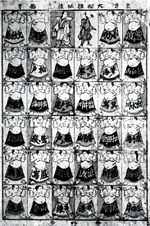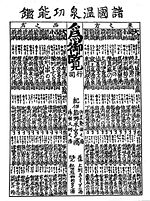
Banzuke
Encyclopedia
This article is about the banzuke document, for a list of wrestlers as ranked on an actual banzuke see List of active sumo wrestlers
 A , officially called is a document listing the rankings of professional sumo
A , officially called is a document listing the rankings of professional sumo
wrestlers published before each official tournament or honbasho
. The term can also refer to the rankings themselves. The document is normally released about two weeks before the tournament begins. On the banzuke wrestlers are divided into East, which is printed on the right, and West, which is printed on the left. Each wrestler's full shikona
(ring name), hometown and rank is also listed. The top of the page starts with the highest ranked makuuchi
wrestlers printed in the largest characters, down to the wrestlers in the lowest divisions which are written in much smaller characters. The name of gyōji
(sumo referees), yobidashi
(ring attendants), shimpan
(judges) and oyakata (elders of the Japan Sumo Association
) are also listed. The form and production of this document has a tradition going back centuries. As is the traditional Japanese style, a banzuke is meant to be read right to left, top to bottom. It is considered a collector's item by sumo fans.

 The rankings on the banzuke are decided by an assembly composed of 20 sumo judges (shimpan) and three supervisors who gather a few days after each official tournament. The assembly assigns ranks to over 800 wrestlers in six divisions based on their performance in the previous tournament. There are no precise rules for assigning rank, but the general rule is that a wrestler who achieved kachikoshi (a majority of wins) will be raised in the rankings and a wrestler with a makekoshi (a majority of losses) will be lowered in the rankings. The degree of a wrestler's success or failure will help give the assembly a benchmark for figuring how far he rises or falls in the rankings.
The rankings on the banzuke are decided by an assembly composed of 20 sumo judges (shimpan) and three supervisors who gather a few days after each official tournament. The assembly assigns ranks to over 800 wrestlers in six divisions based on their performance in the previous tournament. There are no precise rules for assigning rank, but the general rule is that a wrestler who achieved kachikoshi (a majority of wins) will be raised in the rankings and a wrestler with a makekoshi (a majority of losses) will be lowered in the rankings. The degree of a wrestler's success or failure will help give the assembly a benchmark for figuring how far he rises or falls in the rankings.
High-ranking gyōji
then take on the laborious task of copying down the new rankings on a traditional Japanese paper roll called a maki. They carefully write down the kanji
characters of each wrestler participating in a tournament in a calligraphy style called sumo moji. The work is very intricate and requires a great deal of skill. It usually takes about a week to complete the document. The banzuke information is carefully guarded for several weeks before it is released, which is usually on the Monday 13 days before an official tournament begins.
The banzuke is printed at a greatly reduced size on sheets of paper (58 cm x 44 cm) and copies are distributed by the Japan Sumo Association
. Sumo heya
buy a large quantity of them to give to their sponsors. Tea houses in the Tokyo sumo venue Kokugikan
also buy them to give out to their patrons. They are also available for purchase for a small fee at tournament sites.

Sumo
is a competitive full-contact sport where a wrestler attempts to force another wrestler out of a circular ring or to touch the ground with anything other than the soles of the feet. The sport originated in Japan, the only country where it is practiced professionally...
wrestlers published before each official tournament or honbasho
Honbasho
A is an official professional sumo tournament. There are six held each year, a system established in 1958. Only honbasho results matter in determining promotion and relegation for rikishi ....
. The term can also refer to the rankings themselves. The document is normally released about two weeks before the tournament begins. On the banzuke wrestlers are divided into East, which is printed on the right, and West, which is printed on the left. Each wrestler's full shikona
Shikona
A shikona is a sumo wrestler's ring name.As with standard Japanese names, a shikona consists of a 'surname' and a 'given' name, and the full name is written surname first. However, the given name is rarely used outside formal or ceremonial occasions. Thus, the former yokozuna Asashōryū Akinori is...
(ring name), hometown and rank is also listed. The top of the page starts with the highest ranked makuuchi
Makuuchi
or is the top division of professional sumo. Its size is fixed at 42 wrestlers , ordered into five ranks according to their ability as defined by their performance in previous tournaments....
wrestlers printed in the largest characters, down to the wrestlers in the lowest divisions which are written in much smaller characters. The name of gyōji
Gyoji
A Gyōji is a referee in professional sumo wrestling in Japan.Gyōji usually enter the sumo world as teenagers and remain employees of the Sumo Association until they retire aged 65.-Responsibilities:...
(sumo referees), yobidashi
Yobidashi
The yobidashi calls a professional sumo wrestler, or rikishi, to the dohyō immediately prior to his bout...
(ring attendants), shimpan
Shimpan
are the judges of a professional sumo bout. In a sumo honbasho tournament five shimpan sit around the ring to observe which wrestler wins the matchup. When judging tournament bouts they wear formal Japanese dress of otokomono, haori with mon, and hakama...
(judges) and oyakata (elders of the Japan Sumo Association
Japan Sumo Association
The is the body that operates and controls professional sumo wrestling in Japan under the jurisdiction of the Japanese Ministry of Education, Culture, Sports, Science and Technology. Rikishi , gyōji , tokoyama , and yobidashi , are all on the Association's payroll, but the organisation is run...
) are also listed. The form and production of this document has a tradition going back centuries. As is the traditional Japanese style, a banzuke is meant to be read right to left, top to bottom. It is considered a collector's item by sumo fans.
Banzuke preparation


High-ranking gyōji
Gyoji
A Gyōji is a referee in professional sumo wrestling in Japan.Gyōji usually enter the sumo world as teenagers and remain employees of the Sumo Association until they retire aged 65.-Responsibilities:...
then take on the laborious task of copying down the new rankings on a traditional Japanese paper roll called a maki. They carefully write down the kanji
Kanji
Kanji are the adopted logographic Chinese characters hanzi that are used in the modern Japanese writing system along with hiragana , katakana , Indo Arabic numerals, and the occasional use of the Latin alphabet...
characters of each wrestler participating in a tournament in a calligraphy style called sumo moji. The work is very intricate and requires a great deal of skill. It usually takes about a week to complete the document. The banzuke information is carefully guarded for several weeks before it is released, which is usually on the Monday 13 days before an official tournament begins.
The banzuke is printed at a greatly reduced size on sheets of paper (58 cm x 44 cm) and copies are distributed by the Japan Sumo Association
Japan Sumo Association
The is the body that operates and controls professional sumo wrestling in Japan under the jurisdiction of the Japanese Ministry of Education, Culture, Sports, Science and Technology. Rikishi , gyōji , tokoyama , and yobidashi , are all on the Association's payroll, but the organisation is run...
. Sumo heya
Heya
In sumo wrestling, a heya , usually translated into English as stable, is an organization of sumo wrestlers where they train and live. All wrestlers in professional sumo must belong to one. There are currently 49 heya , all but four of which belong to one of five ichimon...
buy a large quantity of them to give to their sponsors. Tea houses in the Tokyo sumo venue Kokugikan
Ryogoku Kokugikan
, also known as Sumo Hall, is an indoor sporting arena located in the Ryōgoku neighborhood of Sumida, one of the 23 wards of Tokyo in Japan, next to the Edo-Tokyo Museum. It is the third building built in Tokyo associated with the name kokugikan. The current building was opened in 1985 and has a...
also buy them to give out to their patrons. They are also available for purchase for a small fee at tournament sites.
See also
- SumoSumois a competitive full-contact sport where a wrestler attempts to force another wrestler out of a circular ring or to touch the ground with anything other than the soles of the feet. The sport originated in Japan, the only country where it is practiced professionally...
- Glossary of sumo termsGlossary of sumo termsThe following words are terms used in sumo wrestling in Japan. azukari : Hold. A kind of draw. After a mono-ii, the gyōji or the shimpan "holds" the result if it was too close to call...
- List of active sumo wrestlers

